Why Does Your Business Need Widgets
How to withstand the competition, keep site visitors, and turn them into customers? Reteno offers an effective solution — website widgets based on user behavior and personal data.
In this article, we will analyze the types of widgets, their goals, and how to effectively use this functionality.
The Power of Widgets
A widget is an additional element of the website interface that allows you to collect visitor data, show them content, engage them in an interaction, and lead to specific pages. Widgets can be built into the site interface or float on top of other elements, block content, or not affect its display. This functionality offers online businesses three main opportunities:
- Convince site visitors to leave contacts.
- Attract customers with interesting offers.
- Collect feedback and user data in surveys.
Let's take a closer look at each of the possibilities.
Subscribers database growth
Direct communications play an essential role in eCommerce. Customers expect personalized communication in the channels that are convenient for them. However, to communicate with users and send them relevant offers to increase sales, you first need to expand your leads and subscriber lists.
The most efficient and easy way to collect contacts is to use smart subscription forms on the site. You can collect not only email addresses but also phone numbers and other data. This will allow you to send notifications to potential and existing customers in different channels with product recommendations and company news.
On average, subscription forms convert 3.8% of website visitors , and the top-performing widgets reach 23.6%.

Drawing attention to promo offers
Interactive widgets will help you showcase relevant offers in a prominent place on your site. To attract and convert more, they can be targeted to customer behavior and data.
With widgets, you can:
- Inform about discounts and sales. According to statistics, popups with special seasonal offers have a conversion rate of 11.9%.
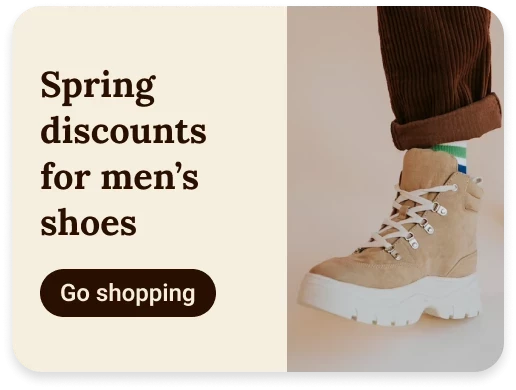
- Product recommendations. Did the buyer choose something from a certain category? Show them a widget with a suggestion to complement it with a related product. According to our statistics, recommendations generate about 20% of online store revenue.
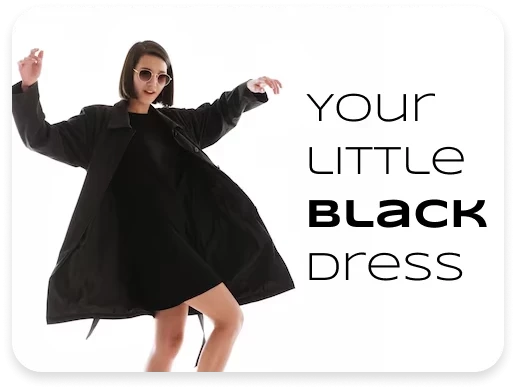
- Create targeted widgets with special offers for a specific audience. You are more likely to convert a website visitor into a customer if you make an offer based on their data. For example, you can display a free shipping widget for customers who made more than three purchases. 49% of survey participants said they purchased a product presented by a company with a personalized message.

Collecting feedback and customer data
To meet the expectations of customers, you need to know everything about their preferences. Where to get such information? You can test content for a long time or use insights from other companies, but the best way to understand what your customers want is to ask them. Statistics show that the average conversion rate for such widgets is 12.6%.
In surveys, you can collect zero-party data, and, on their basis, make personalized offers: select audience segments and target specific consumers.
However, running a survey is not only beneficial for the company but it also provides the customers with a positive experience. Users will feel that their opinions and preferences matter to the business. This will increase the chances of building strong relationships with existing customers and retaining them.
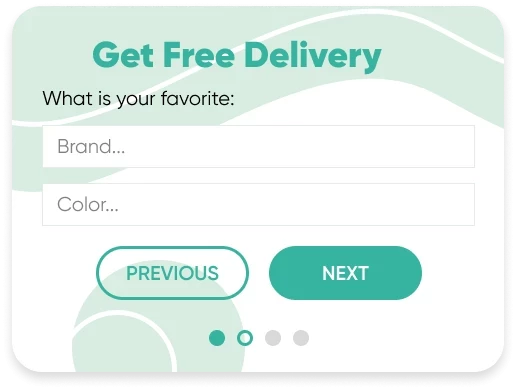
Widget Types
One of the main widget classification criteria is the purpose of their use. Let's take a look at the most common types of widgets.
Subscription form
The subscription form is a must-have for online businesses. Such widgets allow you to collect the subscriber's contact information: name, email, phone number, etc. Users are usually reluctant to share personal information, so it is necessary to encourage them. For example, you can tell the website visitors how they will benefit by signing up for your newsletter. For example, only your subscribers can access exclusive sales or short-term promotions. Another option is to offer the client a bonus for filling out the form — a promotional code or a discount.

Launcher
The launcher allows visitors to open the widget and subscribe at a convenient time. This option makes it possible to attract the attention of users without annoying them once again. The icon always stays on the screen and moves as the page scrolls. It does not overlap the content and allows for using the website seamlessly. Visitors will be able to subscribe at a convenient moment, and you can remind those who have not yet subscribed to do it.

Informer
Informers are clickable widgets to inform site visitors about promotions, discounts, new arrivals, future events, and increased social media engagement. Their use cases are only limited by the imagination of the marketer.
The company can use such widgets to inform customers about general promotions. However, if you have data about user preferences, prepare special offers and display them only for a specific segment.
In addition, you can turn site visitors into application users. For example, an informer can encourage customers who access the mobile version of the site to view more products or track orders more conveniently in the application and lead to a page on Google Play or the App Store.
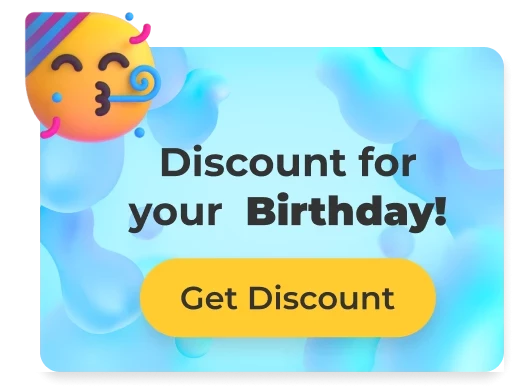
Survey
Businesses use this type of widget to get feedback from customers and collect additional customer data. However, the main task is not only to collect data but also to use it to improve the brand and further communication with users. This is easily handled by the Reteno, which can collect, unify, store, and use different types of data from various sources.
For example, a survey widget allows you to get data about the size of a client's clothes and their favorite brand. In the future, this information can be used to display relevant product recommendations on the site or in email campaigns for a specific user. In addition, you can personalize communication with the client based on the data from the survey.
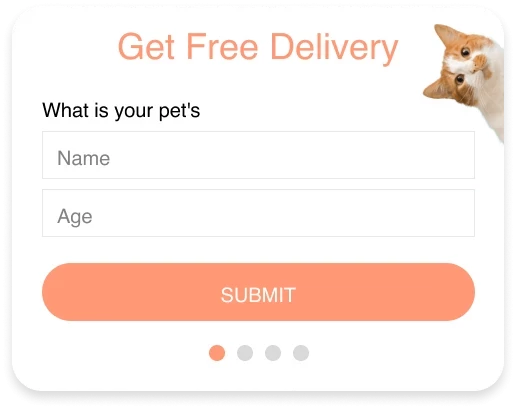
Age gate
The age gate widget requires site visitors to verify their age before browsing. Using this widget is essential for companies whose activities are regulated by special laws, for example, those offering goods and services only for customers who have reached the age of 18. For example, it can be tobacco and alcohol, video games, etc.
To avoid problems, the company is obliged to warn the user about the age restriction.
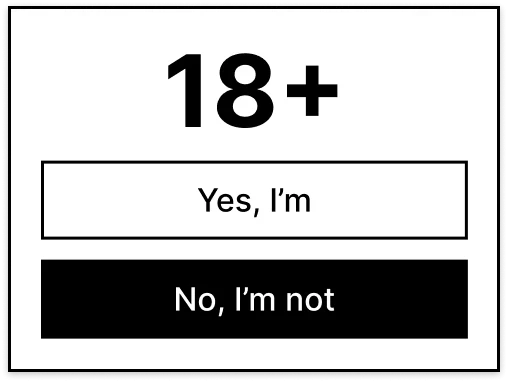
Slider
This type allows you to display several offers to the user in one widget — for example, images of products, several special promotions, or company news.
First, it increases the likelihood that a customer will complete a conversion action. Secondly, it eliminates the need to create separate widgets for multiple offers of the same type.
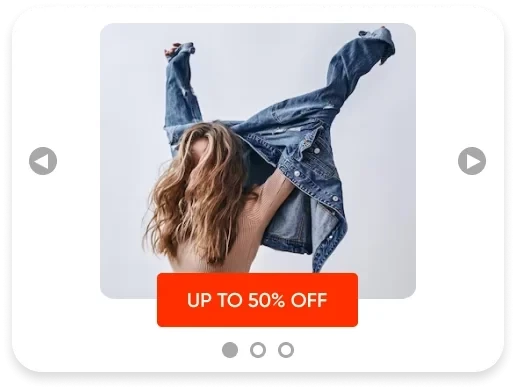
How to Create an Effective Widget
Widgets allow you to communicate with 100% of your website visitors, both identified and anonymous, providing the best user experience and conversion rate. However, in order for them to benefit your company and not encourage visitors to leave the site, there are several widget creation tips to keep in mind. Let's take a closer look at the most important ones.
Design
The widget should harmoniously complement your site, containing high-quality images or videos. It is important not to overload it so that the user immediately sees the main message. So, pay attention to the next points:
- Image. This element can be even more effective if you add a multi-choice carousel to the widget.
- Video. 91% of marketers claim that video marketing has helped them increase their traffic.
- Countdown timer. The timer will help create the FOMO effect and motivate the visitor to click while the offer is valid.
- The number of fields to fill. Large forms may repel visitors. According to the study, widgets with one field had the highest CVR of 4.3% , followed by widgets with four fields with a CVR of 3.5%.
- Adaptability. Do not neglect the mobile version. The average widget conversion rate on the desktop is 9.7% , while the mobile version converts at 11.1%.
Value
The design of your widget is important, but without a relevant offer, users won't respond to it. However, with the help of the following methods, you can increase widget conversion:
- Call to action. First thing first, you should come up with a clear message. The widget’s text is limited, so the site visitor should understand what it is about at a glance. For example, if you are building a subscriber base, note that a person will get the best deals first if they provide an email. If you are running a sale, add information about the product category and the end of the promotion to motivate the customer to click.
- Bonus. Website visitors are more likely to click on a widget if you offer them a benefit. If it is not necessary to add a bonus to a promo popup, then for subscription forms such an element is a must-have. People don't tend to share personal information and expect you to give them something in exchange.
Double opt-in
If you are building an email address database using widgets, you should also take care of the user's consent. To do this, add the data use terms and a checkbox to the subscription form.
In the Reteno system, you can set up automatic sending of a letter in which the user can follow the link and confirm the desire to receive mailings from the company.
This is an important point for collecting client data because their use is regulated by the laws of different countries, in addition to GDPR.
Multilingual feature
Another opportunity to win the favor of users and increase the effectiveness of widgets is the multilingual feature. It allows you to communicate with the site visitor in the language that they prefer and is especially relevant for businesses serving international customers.
However, creating separate language versions of widgets can be time-consuming for marketers. Reteno offers a solution: adding different versions of widgets is easy in the drag-and-drop builder. Create the main version, select the required language, and an additional widget with the same design and settings will appear in the builder. All you have to do is replace the text and the link.
The system itself will determine which version of the widget to show to the user based on data from the contact card or browser language.
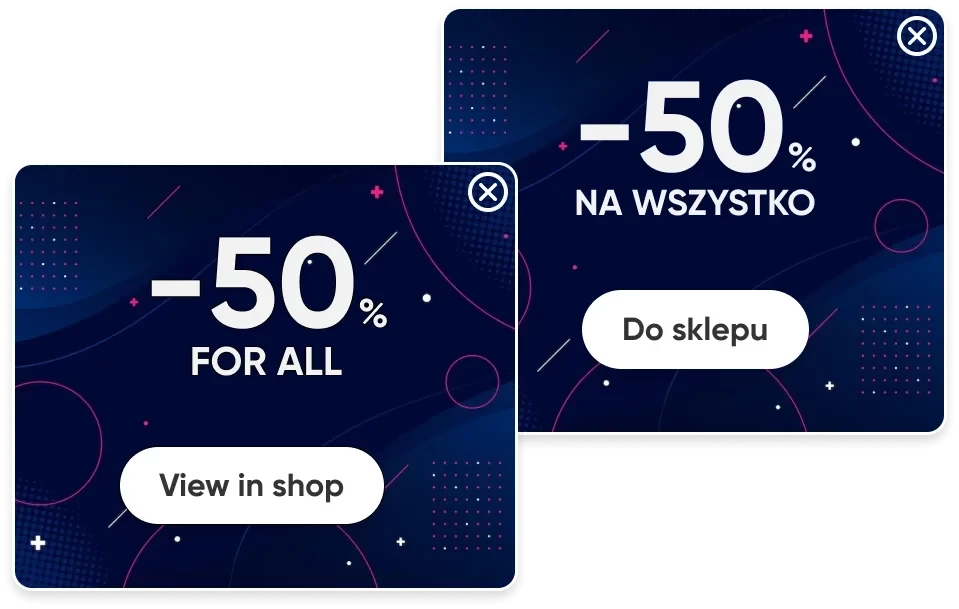
Display conditions
If you create a widget with perfect text and design but don't set the display conditions, it's unlikely to bring the desired results. You need to carefully consider show time, location, and even the number of widgets per site.
In Reteno, you can choose the following rules:
- users in which countries show a widget to,
- user devices (desktop or mobile),
- with what frequency (once per session, for 3 days, etc.),
- when exactly (the user stayed on the page for 40 seconds, was inactive for 1 minute, etc.).
In addition, you can customize the widget on specific website pages by URL, UTM tags, or CSS selector.
Widgets that a marketer customizes for a specific audience at a specific time will bring better results than widgets that are shown to everyone all the time.
However, floating widgets that pop up on the site have a drawback: if you clumsily configure their display, you can irritate site visitors instead of encouraging them to make a target action. To avoid this, Reteno has two features:
- The overlapping protection prevents multiple floating widgets from overlapping each other.
- An annoyance safeguard for avoiding annoying customers sets silence intervals between showing widgets.
Targeting
If your company already uses the widgets’ best practices, there is still a new level you can achieve. It implies making targeted offers based on customer data from the Reteno. Such targeting is available for identified and anonymous visitors. Imagine being able to display widgets with special offers, for example, for loyal customers who have made N number of purchases or for women who follow the updates of a particular brand.
You can implement targeting in the Reteno system using segmentation. To do this, select the desired segment to display the widget using:
- User browsing history
- Purchase history
- Customer preferences
You can also select any segment created in your Reteno account.
It is also important to note that users identified with the help of widgets become available for omnichannel communication with Reteno immediately. This allows you to make relevant offers to customers at a convenient time for them. In addition to widgets, you can attract potential buyers in the following channels:
- Web push
- Mobile push
- In-app
- App inbox
- SMS
All these channels can be combined into workflows to convey the necessary message to the user in a convenient place at a convenient time.
Performance Analysis
To stay updated on your widgets' effectiveness, it is necessary to regularly measure their performance. For performance analysis, you can use statistics on views, subscriptions, clicks, and conversions. So, in Reteno, information about the effectiveness of widgets updated every minute and displayed on charts. This allows you to conveniently monitor performance over a period of time.
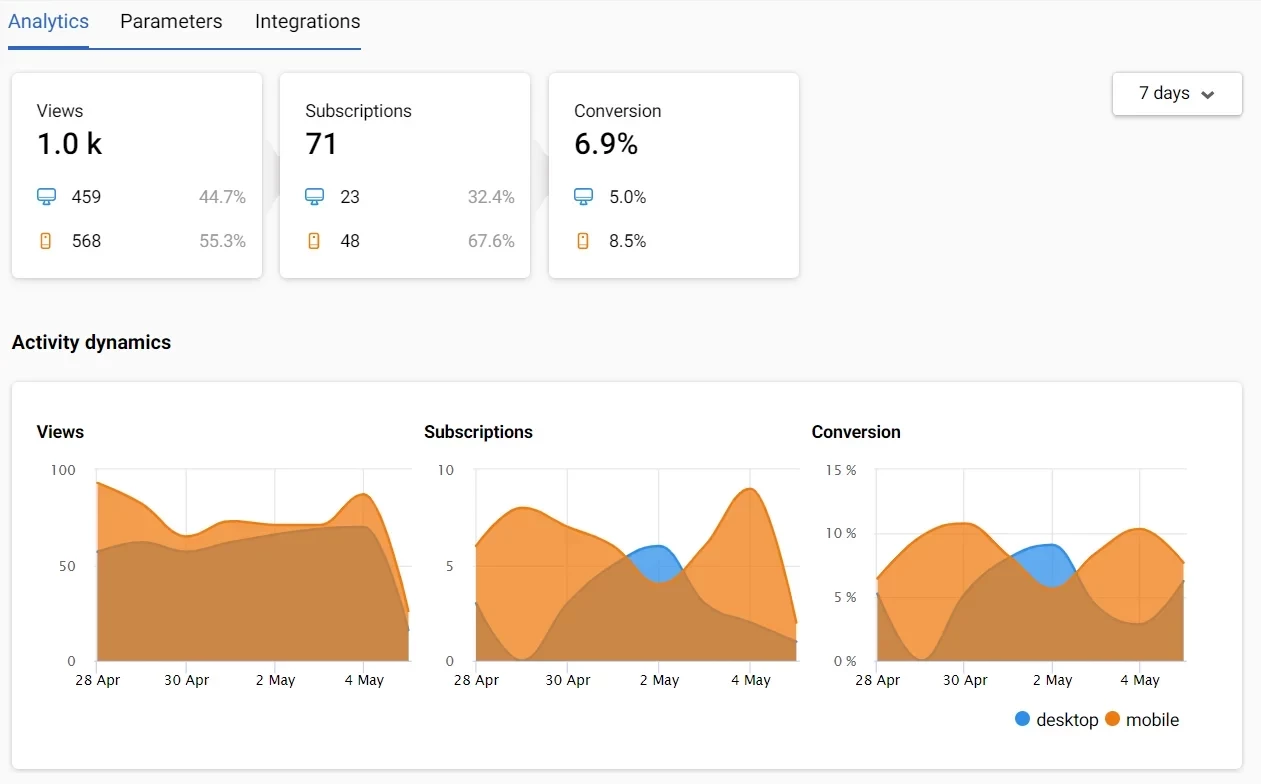
Another option is to pass widget statistics data to Google Analytics. To do this, you need to install the GA script on your site. You can send event data related to user interaction with Reteno widgets to your Google Analytics account: display, clicks, subscriptions, etc.
Updated 3 months ago
